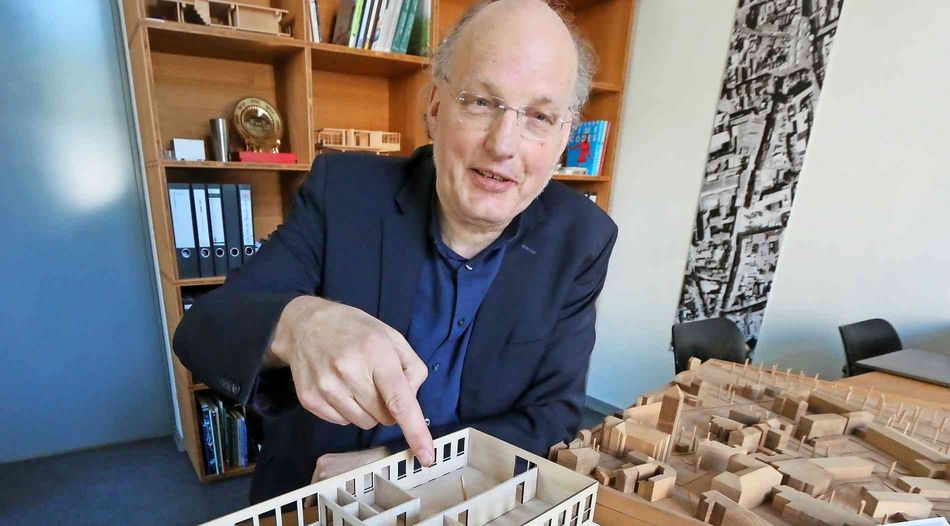
The commitment from Mainz has been received: The building of the former public prosecutor's office at the Irminenfreihof will be completely renovated and converted over the next three years for a total of 13 million euros. Then the students of the Faculty of Architecture will move there from Schneidershof and complete the campus design of the university in the city centre of Trier.
Dean Matthias Sieveke can look out from his office onto the square and the six-storey building. "Something like this would not be allowed here today," says the renowned architect and urban planner, who is considered one of the driving forces behind the new use. "When we started working on this idea together with our students, we had no idea how thick the board to be drilled here would be. But now I am glad. And the sum is right too."
He explains what happens to the building using a scale model. A total of seven studios for the creative work of 20 students each, spacious conference and gallery rooms and a representative two-storey presentation room form the core for teaching and research. "Transparency is the trump card in the building," says Sieveke, and by that she doesn't just mean the window fronts, which will remain intact during the conversion. The large cafeteria with cafeteria on the ground floor is also to be open and communicative. "This is our central element for the campus design with 1000 students at Irminenfreihof and Paulusplatz.
Dean Sieveke is convinced that the area around the two squares will revitalize. University President Dorit Schumann also believes in this effect and therefore calls the new building ensemble an inner city campus. "As an applied university, we seek this proximity to society and the public." In this way, cooperation and knowledge transfer with organizations will become even more visible and can be expanded.
The move of the architecture department to the new building, which is planned in three years, will also have an impact on the main campus. "The expansion now approved is therefore also an investment in the future of the entire university. Because it will give us on the Schneidershof more room to breathe for the other departments. They can also expand their activities in study and teaching as well as research."
The Landesbetrieb Liegenschafts- und Baubetreuung (LBB), which has already removed the asbestos-containing plaster in recent months, is responsible for the conversion of the cubist building at Irminenfreihof. The building is being renovated in accordance with current fire protection and thermal insulation requirements. The concept for the façade design was developed by students in a workshop according to LBB's specifications. Dean Matthias Sieveke is proud of it ("There is a lot of idealism in it on the part of our students") and praises the good cooperation with the regional office and the city of Trier.
The computer visualisation shows the building with a grey shimmering metal façade and an offset open stair tower for the escape routes. The 58-year-old describes the future appearance as "stringent and self-confident". "We will no longer allow cars to park in front of it, but will create space for a cafeteria, lounge and bicycles." He considers possibilities for informal communication to be indispensable. "The conversations on the terrace are just as necessary as the exchange in the seminars." The new cafeteria for the 1000 students should therefore become a central meeting point and promote identification with the campus design. "In the past, our six faculties were separate departments", Matthias Sieveke describes the situation. "Now they belong to a student council. That means that some of them are still strangers."
The reconstruction is scheduled to start this year.
Progress for the city centre - Commentary by Rainer Neubert:
"Trier is a university town. Nevertheless, something is missing to fill this statement with life: Many students in the city center. The campus design could at least change that a little. Once the architecture department has moved to the Irminenfreihof, a total of 1000 young
People enliven the neighbourhood. That's not enough to make the city pulsate. But it is progress. When the Orangerie, which is only a stone's throw away, is converted into an Exhaus location, a new meeting place for the creative scene will have been created, not only for beautiful summer evenings. The old public prosecutor's office building has stood empty long enough. The reconstruction should better start today than tomorrow. The earlier it is completed, the better for the city of Trier and its students."
Text: Rainer Neubert, Volksfreund Trier
You are leaving the official website of Trier University of Applied Sciences